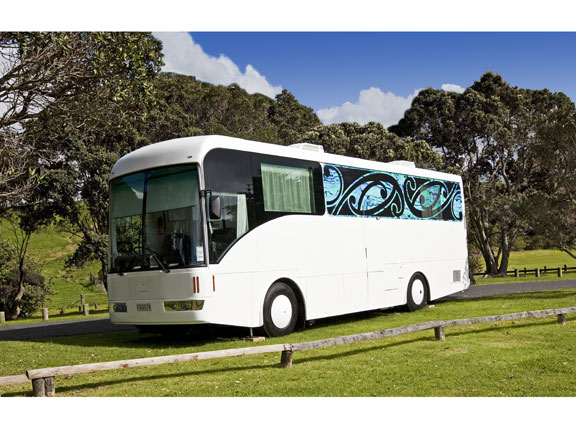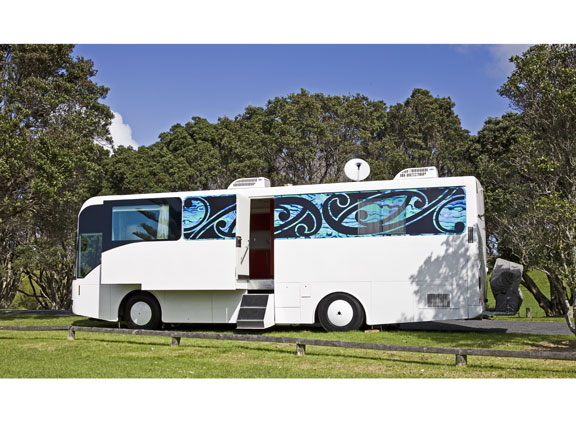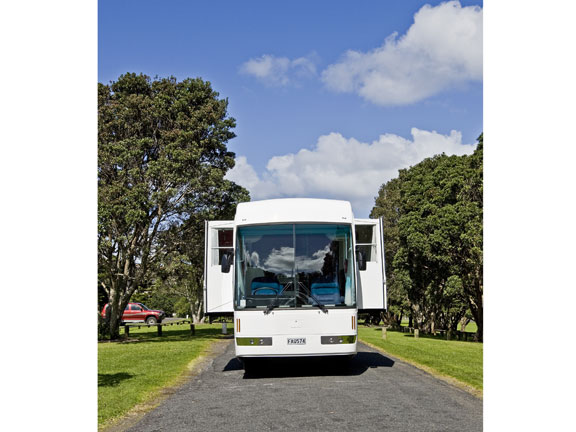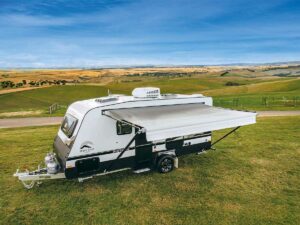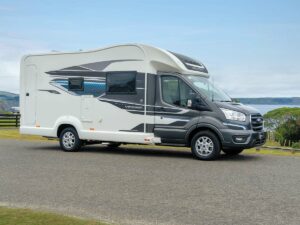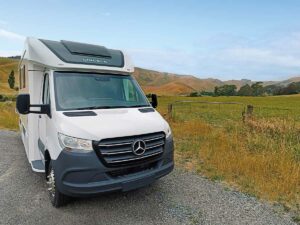Watch Video
But as Martin Wellesley’s custom-built motorhome proves, an unflinching vision and huge piles of money can indeed convert a sow’s ear into a silk purse. As far as recycling models go, this one really gets my vote.
Martin’s not a conventional type; considering his success in the corporate world, his decision to spend a great deal of his life exploring locally, rather than abroad, or indeed his goal of tackling such an ambitious project despite no prior motorhome experience, may seem slightly alternative. But Martin’s unconventionality has filtered through to the design of the bus, and it seemingly has worked in his favour.
Exterior
A few years back Martin approached established coachbuilder, Ian Paterson at Auckland Coach Builders with nothing but the will to go travelling without the slightest compromise to his lifestyle and some hand-drawn doodles that roughly resembled the stylish interior layout seen inside the bus.
It took two years of customisation to get here, and the bus was stripped back essentially to a skeletal frame before the fit-out commenced and that tired exterior extensively remodelled and modernised.
To improve head room inside the roof height was increased to a 2.1m internal height, it has also given the older bus greater presence externally, and the front and rear of the bus incorporate new bodywork that’s smoothed over the original square styling. Martin says he has travelled the country and come across only one holiday park that couldn’t accommodate the 10.5m koru-emblazoned beast.
Interior
Upon parking up, the bus extends load-bearing feet on powerful hydraulic rams that level out uneven ground and add further support when the two large slide-out areas are in place. The dual slide-outs open up a living space of around 21m². There’s entertaining space for a dozen or more people in the open plan living area.
Martin’s not a “motorhome” guy. He wanted a contemporary apartment he could take anywhere and that’s what Auckland Coach Builders has achieved here. All the 12-volt appliances and push and lock type draw fixtures that are standard fare on motorhomes really didn’t appeal to Martin, so wherever possible 240-volt appliances have been utilised, just like what he’s familiar with at home and the kitchen. A full-sized showcase of the interior space has conventional draw fronts and fixtures, although there is a locking system – similar to a mechanic’s toolbox in its operation – that stops everything from flying about on the road.
There’s a dual draw dishwasher, full-size fridge, oven/cooktop and dual sinks in this practical and modern kitchen, which sits opposite a generous bar area and hidden home entertainment hub. From here the quality audio system can be controlled and the living area can easily convert to a home theatre with 5.1 Dolby sound and a huge 46-inch LCD television that flips down from above the driver and passenger seating.
Alternatively this space can convert to a sleeping area with two double beds or bunks if required. Simple curtain dividers are a no-fuss way of adding privacy. Head down the hallway and the rear of the bus houses an air-conditioned double master bedroom with a full single wardrobe, amble cupboard space and is finished with local artwork on the micro-suede lined walls.
The bathroom is roomy and functional. A 750mm square shower is fed from a 400-litre fresh water tank and there’s a macerating toilet with 100-litre tank capacity. It maintains the contemporary look with a bowl-style sink and medicine cabinet with under vanity stowage also. Martin tends to opt for his external shower to reduce the strain on his 400-litre grey water tank.
Storage
There’s plenty of cupboard space, underneath the seating areas, but there’s also a deep under-floor cargo hold that can swallow larger gear like kayaks and the like. The external holds provide stowage for the 3kVA Honda generator and related necessities.
No expense spared
What does something like this cost? Best take a seat for this. Give or take, half a million dollars. Martin has got a lot of use out that investment in the two years since the build was completed and despite being on the market, he’s prepared to hold on to the bus until he gets, give or take, $400k. And why sell? Why else. Bigger and better things, Martin has already got himself a KEA camper to maintain the lifestyle while this bus finds a buyer and he finalises the hand-drawn plans to convert yet another plain Jane servant of public service to a bespoke and shining example of luxury.
Specifications
Model Nissan UA510 1993
Engine 15L V8 diesel
Transmission Five-speed air assisted
Size 10.5m long
Weight Aprox 15-tonne
Power/Batteries 7kWH of electricity from batteries. 3kW Honda generator. Victron inverter enables paralleling inverter and gen to give 6kW power capacity. No solar.
Fridge Domestic Fisher and Paykell
Freshwater tank 400L
Grey water tank 400L
Gas 22kg alloy bottle
Check out the latest issue on sale now or subscribe to Motorhomes, Caravans & Destinations magazine here.
Video
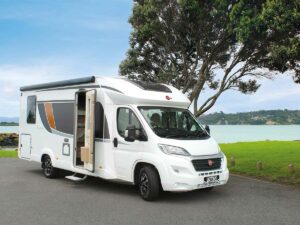
Review: Bürstner Lyseo IT744 Harmony Line
An elegant experience inside and out, the Bürstner Lyseo IT744 makes the most of its dimensions.

